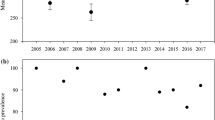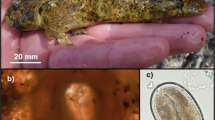Abstract
We evaluated the effects of a buccal cavity attaching Salmincola sp. on white-spotted charr Salvelinus leucomaenis by mark-recapture method to compare body condition, growth, and apparent survival within a headwater stream of the Shiodomari River, Hokkaido, Japan. Prevalence was 13.1–15.5% and the mean intensity was 1.2–1.3 parasites per individual (max = 4). Infected fish were significantly larger than non-infected fish and larger fish had significantly higher apparent survival, but no significant difference was detected in body condition, growth, or apparent survival between infected and non-infected fish. Prevalence and intensity in natural streams may be too low to cause harmful effects on host species.



Similar content being viewed by others
References
Amundsen P, Kristoffersen R, Knudsen R, Klemetsen A (1997) Infection of Salmincola edwardsii (Copepoda: Lernaeopodidae) in an age-structured population of Arctic charr—a long-term study. J Fish Biol 51:1033–1046
Barndt S, Stone J (2003) Infestation of Salmincola californiensis (Copepoda: Lernaeopodidae) in wild coho salmon, steelhead, and coastal cutthroat trout juveniles in a small Columbia River tributary. Trans Am Fish Soc 132:1027–1032
Beldomenico P, Telfer S, Gebert S, Lukomski L, Bennett M, Begon M (2008) Poor condition and infection: a vicious circle in natural populations. Proc R Soc B 275:1753–1759
Boone E, Quinlan H (2019) Occurrence of Salmincola sp. on brook charr Salvelinus fontinalis in Lake Superior. Hydrobiologia 840:301–308
Bowen C, Stedman R (1990) Host-parasite relationships and geographic distribution of Salmincola corpulentus (Copepoda: Lernaeopodidae) on bloater (Coregonus hoyi) stocks in Lake Huron. Can J Zool 68:1988–1994
Kabata Z (1969) Revision of the genus Salmincola Wilson, 1915 (Copepoda: Lernaeopodidae). J Fish Res Board Can 26:2987–3041
Kabata Z, Cousens B (1973) Life cycle of Salmincola californiensis (Dana 1852) (Copepoda: Lernaeopodidae). J Fish Res Board Can 30:881–903
Kearn G (2004) Leeches, lice and lampreys: a natural history of skin and gill parasites of fishes. Springer, Dordrecht
Marschall E, Crowder L (1995) Density-dependent survival as a function of size in juvenile salmonids in streams. Can J Fish Aquat Sci 52:136–140
Mitro M (2016) Brook trout, brown trout, and ectoparasitic copepods Salmincola edwardsii: species interactions as a proximate cause of brook trout loss under changing environmental conditions. Trans Am Fish Soc 145:1223–1233
Monzyk F, Friesen T, Romer J (2015) Infection of juvenile salmonids by Salmincola californiensis (Copepoda: Lernaeopodidae) in reservoirs and streams of the Willamette River Basin, Oregon. Trans Am Fish Soc 144:891–902
Nagasawa K (2020) Salmincola markewitschi (Copepoda: Lernaeopodidae) parasitic on whitespotted char, Salvelinus leucomaenis, in a mountain stream of Honshu Island, central Japan. Species Divers 25:369–375
Nagasawa K, Ishiyama N (2021) Salmincola markewitschi (Copepoda: Lernaeopodidae), a parasite of whitespotted char, Salvelinus leucomaenis, from Ishikawa Prefecture, central Japan. Taxa, Proc Japan Soc Syst Zool 50:11–19
Nagasawa K, Urawa S (1991) New records of the parasitic copepod Salmincola stellatus from Sakhalin taimen (Hucho perryi) in Hokkaido, with a note on its attachment site. Sci Rep Hokkaido Salmon Hatchery 45:57–59
Nagasawa K, Urawa S (2002) Infection of Salmincola californiensis (Copepoda: Lernaeopodidae) on juvenile masu salmon (Oncorhynchus masou) from a stream in Hokkaido. Bull Natl Salmon Resources Center 5:7–12
Nagasawa K, Watanabe JR, Kimura S, Hara A (1994) Infection of Salmincola stellatus (Copepoda: Lernaeopodidae) on Sakhalin taimen Hucho perryi reared in Hokkaido. Bull Fac Fish Hokkaido Univ 45:109–112
Nagasawa K, Yamamoto M, Sakurai Y, Kumagai A (1995) Rediscovery in Japan and host association of Salmincola carpionis (Copepoda: Lernaeopodidae), a parasite of wild and reared freshwater salmonids. Can J Fish Aquat Sci 52:178–185
Nagasawa K, Ikuta K, Nakamura H, Shikama T, Kitamura S (1998) Occurrence and effects of the parasitic copepod Salmincola carpionis on salmonids in the Nikko District, central Japan. J Mar Syst 15:269–272
Nakano S (1995) Competitive interactions for foraging microhabitats in a size-structured interspecific dominance hierarchy of two sympatric stream salmonids in a natural habitat. Can J Zool 73:1845–1854
Poulin R, Conley DC, Curtis MA (1990) Effects of temperature fluctuations and photoperiod on hatching in the parasitic copepod Salmincola edwardsii. Can J Zool 68:1330–1332
R Core Team (2018) R: a language and environment for statistical computing. R Foundation for Statistical Computing, Vienna, Austria. https://www.R-project.org
Ruiz C, Rash J, Besler D, Roberts J, Warren M, Arias C, Bullard S (2017) Exotic "gill lice" species (Copepoda: Lernaeopodidae: Salmincola spp.) infect rainbow trout (Oncorhynchus mykiss) and brook trout (Salvelinus fontinalis) in the Southeastern United States. J Parasitol 103:377–389
Sánchez CA, Becker DJ, Teitelbaum CS, Barriga P, Brown LM, Majewska AA, Hall RJ, Altizer S (2018) On the relationship between body condition and parasite infection in wildlife: a review and meta‐analysis. Ecol Lett 21:1869–1884
Shedko MB, Shedko SV (2002) Parasitic copepods of the genus Salmincola (Lernaeopodidae) from the far eastern chars Salvelinus (Salmonidae) with description of the new species S. markewitschi. Zool Zhurnal 81:141–153 (in Russian)
Sutherland D, Wittrock D (1985) The effects of Salmincola californiensis (Copepoda: Lernaeopodidae) on the gills of farm-raised rainbow trout, Salmo gairdneri. Can J Zool 63:2893–2901
Acknowledgments
We would like to thank two anonymous reviewers for their valuable comments on earlier version of the manuscript. Permission to sample by electrofishing was provided by the Hokkaido Government and Oshima Salmon Propagation Association.
Author information
Authors and Affiliations
Corresponding author
Additional information
Publisher's Note
Springer Nature remains neutral with regard to jurisdictional claims in published maps and institutional affiliations.
About this article
Cite this article
Ayer, C.G., Morita, K., Fukui, S. et al. No apparent effects of the buccal cavity attaching parasite, Salmincola sp. (Copepoda: Lernaeopodidae), on a stream salmonid: a mark-recapture study. Ichthyol Res 69, 261–266 (2022). https://doi.org/10.1007/s10228-021-00835-0
Received:
Revised:
Accepted:
Published:
Issue Date:
DOI: https://doi.org/10.1007/s10228-021-00835-0




